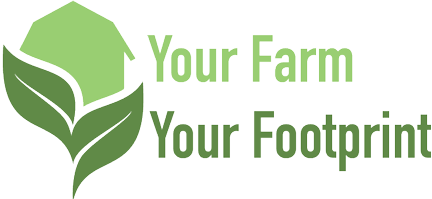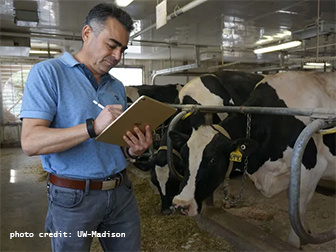PDPW Blog
The Virtual Dairy Farm Brain
Topic Category: Cow Care
Posted May 17, 2019
VIRTUAL DAIRY FARM BRAIN project will help sort cows by nutrition groups, predict mastitis, and identify ketosis.
New developments to the Virtual Dairy Farm Brain project were unveiled at the 2019 PDPW Business Conference. Presenting progress updates on the project were Dr. Victor Cabrera, Virtual Dairy Farm Brain project leader and associate professor of management in the Department of Dairy Science at UW-Madison, graduate student Jorge Barrientos, and post-doctorates Hector Delgado and Lilana Fadul.
Virtual Dairy Farm Brain is a project developed to simplify the complex task producers have of sorting through loads of data to make sound management decisions.
"There are currently silos of data on dairy farms that are each valuable but can't be used together," said Cabrera of the incentive for UW-Madison dairy science and computer science experts to collaborate on a practical solution for dairy farmers.
Multiple datasets are collected from each participating "study" farm and channeled into the Agricultural Data Hub, a single data warehouse. Individual projects then use the data to develop models that will provide decision-making tools to farmers in areas such as ketosis identification, mastitis prediction, and management of nutritional groups.
Finding ways to increase feed efficiencies and maximize milk production from that feed investment is a priority for most farmers. Barrientos shared how the project organizes cows into groups after compiling information from the Agricultural Data Hub, including production data, milk composition, nutrition requirements, and more.
"Our objective is to create a more homogenous group of cows with similar nutritional needs so we can create differentiated rations for each group," Barrientos said.
The nutritional group team is also working on a dashboard tool to monitor and manage data. According to Barrientos, a simulated model of the nutrition-grouping strategy on an 1,800 lactating cow dairy resulted in more than $7,000 in feed-cost savings over a 38-day period, and a nearly $14,500 boost in income over feed cost.
Delgado presented work underway to determine if existing data on dairies can help identify heifers at risk for developing clinical mastitis.
"Knowing that clinical mastitis during the first lactation can have lifelong negative consequences for both health and milk production, we're integrating genomic data, management data and laboratory results," said Delgado.
Delgado shared that the combination of genomic history, cow data and somatic cell count records can provide a warning for high genetic cows at risk for clinical mastitis, even when the somatic cell count is below 200,000.
For many dairy producers, somatic cell count data for individual cows is only available once a month through milk testing. Fadul presented information about a project to integrate milk-parlor and management-software data to develop a model that could give producers a real-time prediction of clinical mastitis.
Using data analysis and machine learning, the team developed an algorithm that predicts onset of clinical mastitis - with an 80 percent accuracy - based on changes in milk conductivity and milk production. Fadul added they saw changes in conductivity and production as early as five milking sessions prior to clinical mastitis being detected.
Dr. Cabrera noted work is moving forward quickly on several projects within the Virtual Dairy Farm Brain program, with hopes of having some of the tools available to producers by June.
New developments to the Virtual Dairy Farm Brain project were unveiled at the 2019 PDPW Business Conference. Presenting progress updates on the project were Dr. Victor Cabrera, Virtual Dairy Farm Brain project leader and associate professor of management in the Department of Dairy Science at UW-Madison, graduate student Jorge Barrientos, and post-doctorates Hector Delgado and Lilana Fadul.
Virtual Dairy Farm Brain is a project developed to simplify the complex task producers have of sorting through loads of data to make sound management decisions.
"There are currently silos of data on dairy farms that are each valuable but can't be used together," said Cabrera of the incentive for UW-Madison dairy science and computer science experts to collaborate on a practical solution for dairy farmers.
Multiple datasets are collected from each participating "study" farm and channeled into the Agricultural Data Hub, a single data warehouse. Individual projects then use the data to develop models that will provide decision-making tools to farmers in areas such as ketosis identification, mastitis prediction, and management of nutritional groups.
Finding ways to increase feed efficiencies and maximize milk production from that feed investment is a priority for most farmers. Barrientos shared how the project organizes cows into groups after compiling information from the Agricultural Data Hub, including production data, milk composition, nutrition requirements, and more.
"Our objective is to create a more homogenous group of cows with similar nutritional needs so we can create differentiated rations for each group," Barrientos said.
The nutritional group team is also working on a dashboard tool to monitor and manage data. According to Barrientos, a simulated model of the nutrition-grouping strategy on an 1,800 lactating cow dairy resulted in more than $7,000 in feed-cost savings over a 38-day period, and a nearly $14,500 boost in income over feed cost.
Delgado presented work underway to determine if existing data on dairies can help identify heifers at risk for developing clinical mastitis.
"Knowing that clinical mastitis during the first lactation can have lifelong negative consequences for both health and milk production, we're integrating genomic data, management data and laboratory results," said Delgado.
Delgado shared that the combination of genomic history, cow data and somatic cell count records can provide a warning for high genetic cows at risk for clinical mastitis, even when the somatic cell count is below 200,000.
For many dairy producers, somatic cell count data for individual cows is only available once a month through milk testing. Fadul presented information about a project to integrate milk-parlor and management-software data to develop a model that could give producers a real-time prediction of clinical mastitis.
Using data analysis and machine learning, the team developed an algorithm that predicts onset of clinical mastitis - with an 80 percent accuracy - based on changes in milk conductivity and milk production. Fadul added they saw changes in conductivity and production as early as five milking sessions prior to clinical mastitis being detected.
Dr. Cabrera noted work is moving forward quickly on several projects within the Virtual Dairy Farm Brain program, with hopes of having some of the tools available to producers by June.






